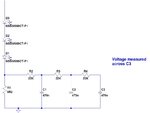T
treez
Guest
Hi,
I have just measured a load of DC voltages on the 200mV range of the handheld XL830L multimeter.
Its just occurred to me that the readings all appear to be some 10% lower than they should be.
Do you know what the input resistance of the XL830L is when on the 200mV range? Its datasheet doesn’t say.
XL830L meter
https://usefulldata.com/wp-content/uploads/2015/09/Excel-XL830L-Multimeter-Instructions-manual.pdf
By the way, the voltage readings were taken downstream of an RC filter consisting of a 66 kiloOhm resistor and 470nF capacitor. (ie taken across the 470nF cap). The origin of the voltage was current flowing through a 0R22 resistor.
++++++++++++++++++++++++++++++++++++++++
Also, on a separate note, please could you confirm that a digital multileter, even if damaged, would never be likely to actually supply current into a node that it was measuring the voltage of. (and thus make that voltage appear higher than it was)
I have just measured a load of DC voltages on the 200mV range of the handheld XL830L multimeter.
Its just occurred to me that the readings all appear to be some 10% lower than they should be.
Do you know what the input resistance of the XL830L is when on the 200mV range? Its datasheet doesn’t say.
XL830L meter
https://usefulldata.com/wp-content/uploads/2015/09/Excel-XL830L-Multimeter-Instructions-manual.pdf
By the way, the voltage readings were taken downstream of an RC filter consisting of a 66 kiloOhm resistor and 470nF capacitor. (ie taken across the 470nF cap). The origin of the voltage was current flowing through a 0R22 resistor.
++++++++++++++++++++++++++++++++++++++++
Also, on a separate note, please could you confirm that a digital multileter, even if damaged, would never be likely to actually supply current into a node that it was measuring the voltage of. (and thus make that voltage appear higher than it was)
